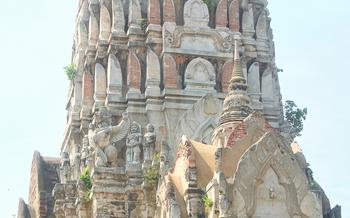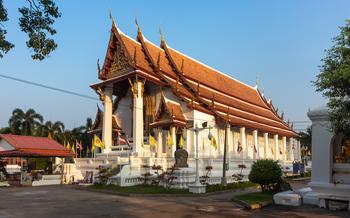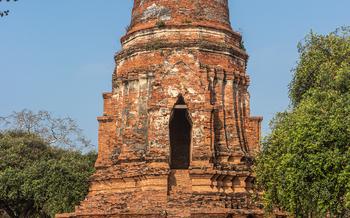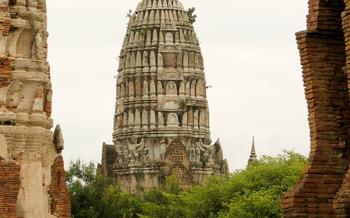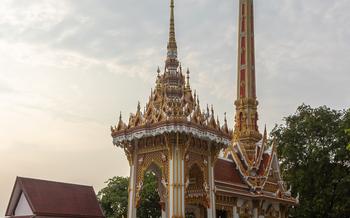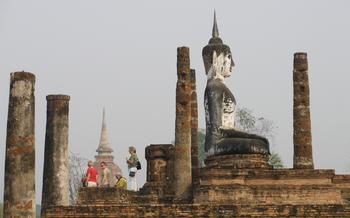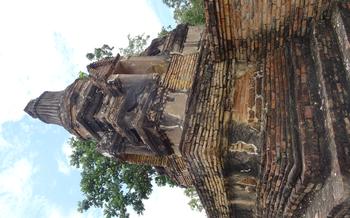
Wat Song Phi Nong
- Wat Song Phi Nong: An Overview
- The Grand Buddha Image
- Exploring the Temple Grounds
- Paying Respect to the Sacred Relics
- The Ordination Hall and Monk's Quarters
- Festivals and Special Events
- Local Beliefs and Legends
- The Surrounding Community
- Accommodation and Dining
- Transportation and Accessibility
- Respectful Etiquette
- Photography and Videography
- Souvenirs and Donations
- Recommended Tours and Guides
- Insider Tip: Unveiling the Hidden Gem of Wat Song Phi Nong
Wat Song Phi Nong: An Overview
Nestled amid the tranquil landscapes of Saraburi, Thailand, lies the revered Wat Song Phi Nong, a sacred temple that holds immense historical and religious significance. Built in 1981 by a renowned monk named Luang Pu Waen Sujinno, this temple has become a prominent pilgrimage site for devotees from across the country. Wat Song Phi Nong is renowned for its colossal Buddha image, intricate carvings, and serene atmosphere, captivating visitors with its spiritual charm.
The temple's unique features set it apart from others in the region. Its sprawling grounds encompass meticulously manicured gardens, serene ponds, and towering stupas, creating a picturesque backdrop for meditation and contemplation. Visitors are immediately drawn to the temple's main attraction – a monumental Buddha image known as the Luang Pho To, which exudes an aura of tranquility and reverence.
Practical information for visitors includes its convenient location just a short drive from Saraburi city center. The temple welcomes visitors daily from 8 am to 5 pm, offering free admission to all. Whether you're a devout Buddhist, a history enthusiast, or simply seeking a peaceful retreat, Wat Song Phi Nong promises an enriching and unforgettable experience.
The Grand Buddha Image
At the heart of Wat Song Phi Nong, visitors are captivated by the awe-inspiring Grand Buddha image, a colossal statue that exudes an aura of serenity and grandeur. Standing tall at 69 meters, this magnificent Buddha sculpture is one of the tallest in Thailand, commanding attention from miles away. Constructed from a combination of concrete and gold leaf, the Buddha exudes an ethereal brilliance, especially when illuminated by the golden rays of the setting sun. The intricate details and serene expression of the Buddha's face radiate a sense of peace and tranquility, inviting visitors to pause and reflect upon the teachings of the Buddha.
Legends and stories abound surrounding the creation of this monumental statue. According to local lore, the Grand Buddha image was commissioned by a wealthy merchant who sought to honor his beloved wife. The merchant spared no expense in creating this masterpiece, ensuring that the finest materials and skilled artisans were employed. The construction process was believed to be guided by divine intervention, with auspicious signs and miracles reported throughout its completion. Today, the Grand Buddha image stands as a testament to the devotion and artistry of the Thai people, attracting pilgrims and visitors from around the world who come to pay homage to this sacred icon.
Exploring the Temple Grounds
As you wander through the temple grounds, you'll be struck by the serene and picturesque surroundings. The air is filled with the gentle sound of birdsong and the rustling of leaves, creating a tranquil atmosphere that invites contemplation. Take your time to explore the intricate carvings that adorn the temple walls, each one telling a story from Buddhist mythology. Marvel at the vibrant murals depicting scenes from the life of the Buddha, adding color and life to the temple's interior.
Don't miss the opportunity to visit the sacred stupas, which are scattered throughout the grounds. These bell-shaped structures are believed to contain relics of the Buddha or his disciples, and they are revered by devotees as symbols of enlightenment and peace. Take a moment to sit in meditation near one of the stupas, allowing the tranquility of the surroundings to wash over you.
Among the many highlights of the temple grounds are the sacred trees, ponds, and gardens. The ancient trees, with their gnarled trunks and lush foliage, are believed to possess spiritual power and are often used as places for meditation and prayer. The ponds, with their crystal-clear water and colorful fish, add a touch of serenity to the temple's landscape. And the gardens, with their vibrant flowers and fragrant plants, create a feast for the senses.
Paying Respect to the Sacred Relics
Within the confines of Wat Song Phi Nong, sacred Buddha relics are enshrined, radiating an aura of reverence and spirituality. These relics, believed to be fragments of the Buddha's remains or personal belongings, hold immense significance for devout Buddhists. Paying respect to these sacred objects is a fundamental aspect of the temple experience.
Devotees approach the relics with a sense of deep devotion, often prostrating themselves in humility and offering prayers. The rituals associated with paying respect vary depending on individual beliefs and practices. Some may light incense sticks or candles, while others may chant mantras or engage in silent meditation. The atmosphere is one of profound serenity, where visitors can immerse themselves in the spiritual energy that permeates the temple grounds.
It is customary for visitors to make a small donation to the temple as a gesture of gratitude and support. These contributions are used to maintain the temple and preserve its sacred relics for future generations. By participating in these rituals and offerings, visitors not only pay homage to the Buddha but also contribute to the preservation of Thailand's rich cultural and religious heritage.
The Ordination Hall and Monk's Quarters
The ordination hall at Wat Song Phi Nong stands as a testament to the temple's significance as a center for religious ceremonies and ordinations. Its architectural design adheres to traditional Thai Buddhist principles, showcasing intricate carvings and ornate embellishments. Inside the ordination hall, an aura of peace and spirituality permeates the air. The walls are adorned with colorful murals depicting scenes from the life of Buddha and his teachings.
The monk's quarters adjacent to the ordination hall provide a glimpse into the daily life and practices of the resident monks. Visitors are welcome to observe the monks' routines, such as their morning and evening chanting sessions, and gain insights into their dedication to the Buddhist faith. Opportunities for interaction with the monks may arise during these sessions, allowing visitors to ask questions and learn more about their beliefs and practices.
Festivals and Special Events
Wat Song Phi Nong comes alive during various festivals and special events throughout the year, each showcasing the temple's rich cultural and religious traditions. One of the most significant events is the annual temple fair, held during the Songkran festival in April. During this time, the temple grounds transform into a vibrant marketplace, with vendors selling traditional Thai handicrafts, food, and souvenirs. Visitors can enjoy lively performances, music, and traditional Thai dance demonstrations that bring the temple to life.
Another notable event is the Kathin ceremony, which takes place in October or November. This ceremony marks the end of the Buddhist Lent season and involves the offering of new robes and other necessities to the monks. Devotees participate in a grand procession, carrying the offerings to the temple while chanting and making merit. Visitors can witness this colorful and sacred ceremony, which is a testament to the strong bond between the temple and the local community.
Local Beliefs and Legends
Wat Song Phi Nong is steeped in local myths, legends, and beliefs that add to its allure and significance. According to one legend, the temple was built on the site where a sacred tree once stood. It is believed that the tree was inhabited by a powerful spirit, and when it was cut down, the spirit became restless and caused misfortune in the area. To appease the spirit, the villagers built the temple and enshrined an image of the Buddha in its place. The Buddha's presence is said to have calmed the spirit and brought peace to the community.
Another legend tells the tale of a young woman named Nang Song Phi Nong who was deeply devoted to the Buddha. One day, while meditating in the forest, she was attacked by a group of bandits. She prayed to the Buddha for protection, and he appeared before her, driving away the bandits and saving her life. In gratitude, Nang Song Phi Nong dedicated her life to serving the Buddha and the temple, and after her death, she became a guardian spirit of the temple, revered by the local people for her kindness and compassion.
These legends and beliefs are deeply ingrained in the local culture and help to shape the community's relationship with the temple. They serve as a reminder of the importance of respecting and honoring the sacred and the role of the temple in preserving and promoting cultural traditions.
The Surrounding Community
Wat Song Phi Nong is deeply intertwined with the local community, serving as a spiritual and cultural hub for the surrounding area. The temple's presence has shaped the local way of life, fostering a strong sense of community and preserving traditional practices. Locals often gather at the temple for religious ceremonies, festivals, and community events, strengthening their bonds and upholding their shared heritage.
One of the unique aspects of the local culture is the annual buffalo sacrifice ritual, held during the Songkran festival. This ancient tradition involves sacrificing a buffalo to honor the temple and bring good fortune to the community. While this practice may seem unusual to outsiders, it holds deep significance for the locals, who believe that the buffalo's sacrifice ensures prosperity and protection for the coming year.
Visitors to Wat Song Phi Nong have the opportunity to immerse themselves in the local culture by attending these festivals and events. By participating in these celebrations, they gain a deeper understanding of the community's beliefs and traditions, creating a richer and more meaningful travel experience.
Accommodation and Dining
Wat Song Phi Nong offers a serene retreat for visitors seeking a peaceful and immersive experience. For those planning to stay overnight, several affordable and comfortable accommodation options are available nearby. Budget-friendly guesthouses and mid-range hotels offer clean and cozy rooms, often with stunning views of the temple grounds. For a truly authentic experience, consider staying at the temple's own guesthouse, where visitors can immerse themselves in the tranquil atmosphere and engage with the resident monks.
When it comes to dining, the surrounding area boasts a range of culinary delights. Local restaurants and eateries serve up mouthwatering Thai cuisine, using fresh ingredients and traditional recipes. From aromatic curries and spicy stir-fries to refreshing salads and sweet desserts, there's something to satisfy every palate. For those seeking vegetarian or vegan options, several restaurants offer a variety of plant-based dishes, ensuring that everyone can savor the local flavors.
Transportation and Accessibility
Reaching Wat Song Phi Nong from Bangkok or other major cities in Thailand is relatively straightforward. Several transportation options are available, catering to different preferences and budgets.
One convenient option is to take a bus from Bangkok's Northern Bus Terminal (Mo Chit). Buses depart frequently throughout the day and take approximately 2-3 hours to reach Saraburi. From there, you can take a local bus or taxi to the temple.
For those who prefer a more scenic journey, trains are available from Bangkok's Hua Lamphong Railway Station. The train ride offers stunning views of the Thai countryside and takes about 3-4 hours. Once you arrive at Saraburi Railway Station, you can take a tuk-tuk or taxi to the temple.
If you're traveling on a tight schedule or prefer the comfort of a private vehicle, taxis or ride-sharing services are readily available. The journey from Bangkok to Wat Song Phi Nong by car takes approximately 2 hours, depending on traffic conditions.
When negotiating fares with taxi drivers or tuk-tuk drivers, it's essential to be polite but firm. Agree on a price before getting into the vehicle to avoid misunderstandings. Local buses are typically inexpensive, but it's a good idea to have some small change on hand as they may not have change for large bills.
Respectful Etiquette
When visiting Wat Song Phi Nong, it is important to observe proper etiquette and customs to show respect for the sacred site and its community. Here are some guidelines to keep in mind:
-
Dress appropriately: Visitors should dress modestly and conservatively, avoiding shorts, tank tops, or revealing clothing. It is customary to cover your shoulders and knees when entering the temple grounds.
-
Maintain a respectful demeanor: Be mindful of your behavior and speech, avoiding loud noises, boisterous laughter, or disruptive actions. Remember that the temple is a place of worship and meditation, and silence is often observed in certain areas.
-
Remove your shoes: Before entering the temple's main buildings, such as the ordination hall or the Buddha image chamber, it is customary to remove your shoes and leave them neatly arranged outside.
-
Respect the monks: Monks are highly revered in Thai culture. When interacting with them, show respect by bowing your head slightly, using polite language, and maintaining a humble attitude. Avoid touching or making physical contact with the monks unless they initiate it.
-
Observe local customs: Be aware of local customs and traditions related to temple visits. For example, it is customary to make a small donation to the temple upon entering, and to pay respect to the Buddha image by offering flowers, incense, or candles.
Photography and Videography
Wat Song Phi Nong welcomes visitors to capture the beauty of the temple and its surroundings through photography and videography. However, it's essential to be mindful of the temple's serene atmosphere and the privacy of other visitors. Photography and videography are generally permitted in the temple grounds, but certain areas or activities may have restrictions.
When taking photos or videos, it's important to avoid using flash photography, as it can be disruptive to the monks and other visitors. Additionally, using tripods or other bulky equipment may not be allowed in certain areas. It's always best to ask permission from the temple authorities or a monk before setting up any equipment.
While capturing the grandeur of the temple is encouraged, it's crucial to respect the sanctity of the religious practices taking place. Avoid taking photos or videos of monks engaged in rituals or prayers without their consent. It's also essential to refrain from using the temple as a backdrop for inappropriate or disrespectful poses or activities.
By following these guidelines and maintaining a respectful demeanor, visitors can capture beautiful memories of their visit to Wat Song Phi Nong while preserving the temple's sacred atmosphere.
Souvenirs and Donations
Wat Song Phi Nong offers a variety of souvenirs and religious items for purchase, allowing visitors to take home a piece of their temple experience. These items may include Buddha statues, amulets, prayer beads, and other devotional objects. The sale of these items helps to support the temple's maintenance and preservation efforts, ensuring that this sacred site remains a vibrant and welcoming place for generations to come.
Making a donation to Wat Song Phi Nong is considered a meritorious act, and visitors are encouraged to contribute if they feel so inclined. Donations can be made in cash or through donation boxes located throughout the temple grounds. These contributions are used to support the temple's ongoing expenses, such as the upkeep of the buildings, the provision of food and shelter for the monks, and the organization of religious ceremonies and festivals.
By purchasing souvenirs or making donations, visitors can not only take home a tangible reminder of their visit but also contribute to the preservation of this sacred site and support the local community.
Recommended Tours and Guides
Exploring Wat Song Phi Nong with a knowledgeable guide can greatly enhance your experience and provide deeper insights into the temple's history, significance, and local traditions. Consider joining a guided tour or hiring a local guide who can share their expertise and passion for this sacred site.
Guided tours typically cover the temple's main highlights, such as the Grand Buddha image, the ordination hall, and the sacred relics. They often include explanations of the temple's history, cultural significance, and the rituals and customs practiced by the monks.
When choosing a tour or guide, look for reputable operators who are knowledgeable, respectful, and experienced in guiding visitors through sacred sites. Consider reading online reviews or asking for recommendations from your hotel or local tourism office.
Having a guide can help you navigate the temple grounds efficiently, ensuring you don't miss any important features or hidden gems. They can also provide insights into the local culture, customs, and beliefs associated with the temple, offering a more immersive and meaningful experience.
Whether you choose to explore Wat Song Phi Nong independently or with a guide, remember to approach the temple with respect and an open mind. Embrace the opportunity to learn about its history, significance, and the local traditions that make it a cherished destination for both pilgrims and travelers.
Insider Tip: Unveiling the Hidden Gem of Wat Song Phi Nong
Beyond the main attractions of Wat Song Phi Nong, there lies a hidden gem waiting to be discovered by curious travelers. Tucked away in a serene corner of the temple grounds is a secluded meditation garden, adorned with lush greenery, tranquil ponds, and vibrant flowers. This serene oasis offers a sanctuary for those seeking inner peace and a deeper connection with the temple's spiritual essence. Visitors can find respite from the bustling crowds, immerse themselves in the tranquility of nature, and engage in mindful meditation amidst the serene surroundings. Whether you're a seasoned meditator or simply seeking a moment of reflection, this hidden garden provides the perfect ambiance to unwind, recharge, and find solace within the sacred space of Wat Song Phi Nong.

